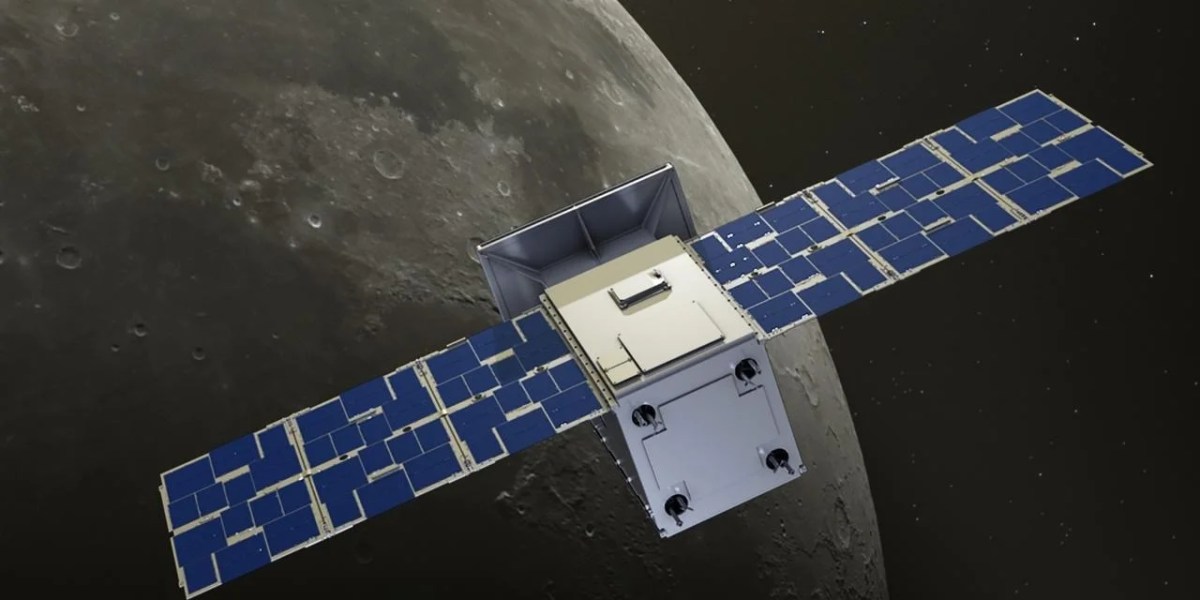GOLDEN, Colorado – Sent moonward over two years ago, NASA’s Cislunar Autonomous Positioning System Technology Operations and Navigation Experiment — shortened to CAPSTONE — is busy as ever, presently trial-running techniques to enhance spacecraft operations in cislunar space.
Launched on June 28, 2022, aboard a Rocket Lab Electron booster from New Zealand, CAPSTONE, a microwave oven-sized cubesat weighing a modest 25 kilograms, is on task and operational in Near Rectilinear Halo Orbit (NRHO) around the moon.
NRHO is the intended orbit of NASA’s cislunar Gateway space station, which is meant to serve as an outpost for long-term human exploration of the moon and beyond. It will also allow crews to access the lunar south pole — an early priority zone for the space agency’s Artemis program.
Overcoming early glitches
It has not been all smooth sailing for CAPSTONE. Early in its mission, a balky thruster sent the probe into rapid tumble mode. It also overcame a propellant freeze, among other glitches.
Having overcome those technical problems, the spacecraft is now slated for cislunar space operations for several more months, said Thomas Gardner, chief engineer for Advanced Space of Westminster, Colorado, which owns and will operate CAPSTONE for the entirety of its mission.
“Advanced Space is working with other potential customers within NASA and other government agencies, like the Air Force Research Laboratory, to provide testing opportunities for their experiments,” Gardner told SpaceNews.
These experiments are primarily focused on autonomous Precision Navigation and Timing, said Gardner, and other operations in the cislunar domain including communication relay services as well as the rendezvous, proximity operations and docking of spacecraft. According to NASA, the price tag of the mission is roughly $30 million, which includes a $10 million launch vehicle procurement from Rocket Lab. The spacecraft was built by Terran Orbital (formerly Tyvak Nano-Satellite Systems) under a commercial subcontract with Advanced Space.
Software test platform
CAPSTONE relies on the Cislunar Autonomous Positioning System (CAPS), a real-time system for estimating absolute position and velocity for spacecraft operating in the cislunar environment.
The cubesat is outfitted with a JPL-provided, onboard chip scale atomic clock to precisely determine the spacecraft’s coordinates in space and time. Gardner explained that Advanced Space has successfully demonstrated the CAPS autonomous navigation technology using both two-way ranging with NASA’s moon-circling Lunar Reconnaissance Orbiter and one-way uplink ranging with JPL’s Deep Space Network.
In addition to testing the CAPS navigation system software, Gardner said there’s an ongoing effort to evaluate a broad suite of software-based capabilities as well, which involves tapping an additional computer onboard CAPSTONE. That computer allows ground controllers to run software without interfering with spacecraft operations.
“Essentially, it’s the only software test platform in cislunar space,” said Gardner.
Deep space maneuvering
Among the software being tested, Gardner said, is the Neural Networks for Enhanced Planning software, which calculates optimal maneuvers for autonomous station keeping — keeping an active spacecraft in the same orbit as another vehicle — and also validates safe and predictable maneuvers for satellites that use electrical or chemical propulsion.
There’s also a SigmaZero software package that identifies anomalies in a spacecraft’s behavior, determines what is causing the error and classifies the anomaly data so that operators can make informed course-correcting decisions.
In addition, a Flight Dynamics System is appraising the ability to provide rapid-turnaround navigation and maneuver planning for deep space and cislunar missions.
“We’re testing each software system independently, then as an ensemble to see how the spacecraft responds,” Gardner said.
The combined capabilities of these three algorithms will be an integrated suite called Autopilot, said Gardner.
“By testing maneuver planning, flight board operations and cislunar autonomy,” Gardner added, “we’ll ultimately end up with a spacecraft that knows where it is, what time it is, how to maneuver correctly and how to validate maneuvers with integrity.”
Lessons from lunar orbit
Meanwhile, the NASA Gateway team is receiving briefings on the lessons learned about operations in NRHO from Advanced Space.
Gardner says that there are several key takeaways for small spacecraft operating in deep space. For one, providers need to make certain they understand system requirements well before preliminary design review.
“Commercial off-the-shelf products often are not developed as advertised,” Gardner advised. “Understand clearly how your system will interact with ground systems — for example, the Deep Space Network. Plugging into them is not as simple as advertised,” he said.
Another lesson learned is to allow extra time to obtain the appropriate regulatory approvals, Gardner said, that often require far more time and resources than expected.
Obtaining other approvals can affect spacecraft operations as well, such as getting the go-ahead to use certain radio frequencies, or addressing matters of planetary protection and orbital debris. Then there are range safety requirements for launch, and export control if a payload is sent spaceward from an overseas provider.
Lastly, “read your telemetry carefully to determine what’s happening based on the data you are receiving,” Gardner said.
Ultimately, Gardner said, the CAPSTONE and ground support teams are eager to continue making use of the spacecraft to support and showcase various tasks in the unique cislunar environment for the rest of its mission.
